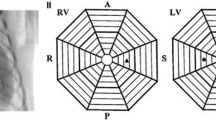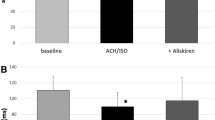Abstract
Purpose
To compare the effects of class III antiarrhythmic agents (amiodarone vs. ibutilide) on ventricular fibrillation (VF) and hemodynamic status in a canine heart failure (HF) model.
Methods
A total of 12 beagles were used to establish the HF model by rapid pacing for 4 consecutive weeks. These canines were randomly divided into two groups based on the administration of ibutilide and amiodarone. A 12 × 12 unipolar electrode plaque was used for ventricular epicardial mapping, and a 6-electrode plunge needle was inserted for ventricular transmural mapping. The restitution curve was estimated from activation recovery intervals (ARIs) by pacing from the plaque electrodes before and after drug administration. The defibrillation threshold (DFT) and VF activation patterns, including the activation rate, cycle length (VF-CL) and the transmural dispersion of the activation rate, were evaluated and the hemodynamic parameters were mearsured and compared before and after drug administration.
Results
Compared to HF baseline, ibutilide administration has markedly decreased the DFT by 28% (18 ± 2 J vs. 13 ± 2.7 J, P < 0.01) without affecting the canine’s hemodynamics (mean arterial pressure 91 ± 15 mmHg vs. 92 ± 17 mmHg, P > 0.05). Furthermore, VF activation pattern became more organized, and spontaneous termination was observed only after ibutilide administration. Conversely, amiodarone has significantly compromised the hemodynamic status (mean arterial pressure 92 ± 6.1 mmHg vs. 52 ± 11.6 mmHg, P < 0.05), but did not alter the DFT (17 ± 2.3 J vs. 16 ± 2.0 J, P > 0.05). Compared to pre-medication, both ibutilide and amiodarone have significantly prolonged the VERP (178 ± 9.6 ms vs. 208 ± 8.9 ms, P < 0.05; 185 ± 10.5 ms vs. 202 ± 7.5 ms, P < 0.05, respectively) and reduced the dispersion of refractoriness, the maximal slope of restitution curve, and the epicardial dispersion during pacing. Additionally, both drugs have significantly increased the VF-CL and reduced the transmural dispersion of the VF activation rate.
Conclusions
Ibutilide had potential antifibrillatory properties, which was shown by decreasing the DFT and organizing the VF activation in HF, and with no apparent impact on the hemodynamic status. In contrast, intravenous amiodarone administration demonstrated prominent negative effects on the hemodynamic status possibly by affecting the myocardial contractility before and after defibrillation but did not alter the DFT.





Similar content being viewed by others
References
Ferreira-Gonzalez I, Dos-Subira L, Guyatt GH. Adjunctive antiarrhythmic drug therapy in patients with implantable cardioverter defibrillators: a systematic review. Eur Heart J. 2007;28(4):469–77.
Lorvidhaya P, Addo K, Chodosh A, Iyer V, Lum J, Buxton AE. Sudden cardiac death risk stratification in patients with heart failure. Heart Fail Clin. 2011;7(2):157–74 vii.
Weeks PA, Sieg A, Gass JA, Rajapreyar I. The role of pharmacotherapy in the prevention of sudden cardiac death in patients with heart failure. Heart Fail Rev. 2016;21(4):415–31.
Kosinski EJ, Albin JB, Young E, Lewis SM, LeLand OS Jr. Hemodynamic effects of intravenous amiodarone. J Am Coll Cardiol. 1984;4(3):565–70.
Munoz A, Karila P, Gallay P, et al. A randomized hemodynamic comparison of intravenous amiodarone with and without tween 80. Eur Heart J. 1988;9(2):142–8.
Friedrichs GS, Chi L, Black SC, Manley PJ, Oh JY, Lucchesi BR. Antifibrillatory effects of ibutilide in the rabbit isolated heart: mediation via ATP-dependent potassium channels. J Pharmacol Exp Ther. 1993;266(3):1348–54.
Wesley RC Jr, Farkhani F, Morgan D, Zimmerman D. Ibutilide: enhanced defibrillation via plateau sodium current activation. Am J Phys. 1993;264(4 Pt 2):H1269–74.
Wood MA, Stambler BS, Ellenbogen KA, et al. Suppression of inducible ventricular tachycardia by ibutilide in patients with coronary artery disease. Ibutilide Investigators. Am Heart J. 1998;135(6 Pt 1):1048–54.
Labhasetwar V, Underwood T, Heil RW Jr, Gallagher M, Langberg J, Levy RJ. Epicardial administration of ibutilide from polyurethane matrices: effects on defibrillation threshold and electrophysiologic parameters. J Cardiovasc Pharmacol. 1994;24(5):826–40.
Sendra-Ferrer M, Gonzalez MD. Ibutilide for the control of refractory ventricular tachycardia and ventricular fibrillation in patients with myocardial ischemia and hemodynamic instability. J Cardiovasc Electrophysiol. 2019;30(4):503–10.
Jin Q, Zhou J, Zhang N, et al. Ibutilide decreases defibrillation threshold by the reduction of activation pattern complexity during ventricular fibrillation in canine hearts. Chin Med J. 2012;125(15):2701–7.
Stambler BS, Beckman KJ, Kadish AH, et al. Acute hemodynamic effects of intravenous ibutilide in patients with or without reduced left ventricular function. Am J Cardiol. 1997;80(4):458–63.
Jin Q, Zhou J, Zhang N, et al. Defibrillation threshold varies during different stages of ventricular fibrillation in canine hearts. Heart Lung Circ. 2013;22(2):133–40.
Mahajan A, Shiferaw Y, Sato D, et al. A rabbit ventricular action potential model replicating cardiac dynamics at rapid heart rates. Biophys J. 2008;94(2):392–410.
Koller ML, Riccio ML, Gilmour RF Jr. Dynamic restitution of action potential duration during electrical alternans and ventricular fibrillation. Am J Phys. 1998;275(5 Pt 2):H1635–42.
Dhein S, Muller A, Gerwin R, Klaus W. Comparative study on the proarrhythmic effects of some antiarrhythmic agents. Circulation. 1993;87(2):617–30.
Banville I, Gray RA. Effect of action potential duration and conduction velocity restitution and their spatial dispersion on alternans and the stability of arrhythmias. J Cardiovasc Electrophysiol. 2002;13(11):1141–9.
Watanabe MA, Koller ML. Mathematical analysis of dynamics of cardiac memory and accommodation: theory and experiment. Am J Physiol Heart Circ Physiol. 2002;282(4):H1534–47.
Huang J, Skinner JL, Rogers JM, Smith WM, Holman WL, Ideker RE. The effects of acute and chronic amiodarone on activation patterns and defibrillation threshold during ventricular fibrillation in dogs. J Am Coll Cardiol. 2002;40(2):375–83.
Fain ES, Lee JT, Winkle RA. Effects of acute intravenous and chronic oral amiodarone on defibrillation energy requirements. Am Heart J. 114(1 Pt 1):8–17.
Jacob S, Pidlaoan V, Singh J, Bharadwaj A, Patel MB, Carrillo A. High defibrillation threshold: the science, signs and solutions. Ind Pacing Electrophysiol J. 2010;10(1):21–39.
Tabereaux PB, Dosdall DJ, Ideker RE. Mechanisms of VF maintenance: wandering wavelets, mother rotors, or foci. Heart Rhythm. 2009;6(3):405–15.
Behrens S, Li C, Franz MR. Effects of long-term amiodarone treatment on ventricular-fibrillation vulnerability and defibrillation efficacy in response to monophasic and biphasic shocks. J Cardiovasc Pharmacol. 1997;30(4):412–8.
Zhou L, Chen BP, Kluger J, Fan C, Chow MS. Effects of amiodarone and its active metabolite desethylamiodarone on the ventricular defibrillation threshold. J Am Coll Cardiol. 1998;31(7):1672–8.
Lee KS. Ibutilide, a new compound with potent class III antiarrhythmic activity, activates a slow inward Na+ current in Guinea pig ventricular cells. J Pharmacol Exp Ther. 1992;262(1):99–108.
Reiffel JA, Blitzer M. The actions of ibutilide and class Ic drugs on the slow sodium channel: new insights regarding individual pharmacologic effects elucidated through combination therapies. J Cardiovasc Pharmacol Ther. 2000;5(3):177–81.
Nash MP, Mourad A, Clayton RH, et al. Evidence for multiple mechanisms in human ventricular fibrillation. Circulation. 2006;114(6):536–42.
Makikallio TH, Huikuri HV, Myerburg RJ, et al. Differences in the activation patterns between sustained and self-terminating episodes of human ventricular fibrillation. Ann Med. 2002;34(2):130–5.
Wu TJ, Lin SF, Baher A, et al. Mother rotors and the mechanisms of D600-induced type 2 ventricular fibrillation. Circulation. 2004;110(15):2110–8.
Jin Q, Chen X, Smith WM, Ideker RE, Huang J. Effects of procainamide and Sotalol on restitution properties, dispersion of refractoriness, and ventricular fibrillation activation patterns in pigs. J Cardiovasc Electrophysiol. 2008;19(10):1090–7.
Jin Q, Dosdall DJ, Li L, Rogers JM, Ideker RE, Huang J. Verapamil reduces incidence of reentry during ventricular fibrillation in pigs. Am J Physiol Heart Circ Physiol. 2014;307(9):H1361–9.
Cushing DJ, Cooper WD, Gralinski MR, Lipicky RJ. The hypotensive effect of intravenous amiodarone is sustained throughout the maintenance infusion period. Clin Exp Pharmacol Physiol. 2010;37(3):358–61.
Doshi D, Jayawardana R. Amiodarone-induced life-threatening refractory hypotension. Am J Case Rep. 2015;16:617–20.
Goldberger AL. A specific ECG triad associated with congestive heart failure. Pacing Clin Electrophysiol. 1982;5(4):593–9.
Chinitz JS, Cooper JM, Verdino RJ. Electrocardiogram voltage discordance: interpretation of low QRS voltage only in the limb leads. J Electrocardiol. 2008;41(4):281–6.
Behrens S, Li C, Franz MR. Effects of myocardial ischemia on ventricular fibrillation inducibility and defibrillation efficacy. J Am Coll Cardiol. 1997;29(4):817–24.
Cimini MG, Brunden MN, Gibson JK. Effects of ibutilide fumarate, a novel antiarrhythmic agent, and its enantiomers on isolated rabbit myocardium. Eur J Pharmacol. 1992;222(1):93–8.
Hester JB, Gibson JK, Cimini MG, et al. N-[(omega-amino-1-hydroxyalkyl)phenyl]methanesulfonamide derivatives with class III antiarrhythmic activity. J Med Chem. 1991;34(1):308–15.
Nabih MA, Prcevski P, Fromm BS, et al. Effect of ibutilide, a new class III agent, on sustained atrial fibrillation in a canine model of acute ischemia and myocardial dysfunction induced by microembolization. Pacing Clin Electrophysiol. 1993;16(10):1975–83.
Tisdale JE, Overholser BR, Sowinski KM, et al. Pharmacokinetics of ibutilide in patients with heart failure due to left ventricular systolic dysfunction. Pharmacotherapy. 2008;28(12):1461–70.
Funding
This study was funded by grants from the National Natural Science Foundation of China (No. 81600270) and the Shanghai Science and Technology Committee (No. 16140904602).
Author information
Authors and Affiliations
Corresponding authors
Ethics declarations
Conflict of Interest
The authors declare that they have no conflict of interests.
Ethical Approval
All animals were acquired from the Shanghai Jiao Tong University Agriculture College (China) and raised under controlled conditions at the Department of Animals for Scientific Research, Shanghai Jiao Tong University School of Medicine. All the study procedures were approved by the Shanghai Jiao Tong University School of Medicine Animal Care and Use Committee in accordance with the recommendations from the Guide for the Care and Use of Laboratory Animals of the National Institutes of Health (eighth edition, 2011).
Additional information
Publisher’s Note
Springer Nature remains neutral with regard to jurisdictional claims in published maps and institutional affiliations.
Rights and permissions
About this article
Cite this article
Zhang, N., Luo, Q., Jin, Q. et al. Ibutilide Reduces Ventricular Defibrillation Threshold and Organizes Ventricular Fibrillation Activation in Canine Heart Failure Model. Cardiovasc Drugs Ther 34, 323–334 (2020). https://doi.org/10.1007/s10557-020-06958-2
Published:
Issue Date:
DOI: https://doi.org/10.1007/s10557-020-06958-2




